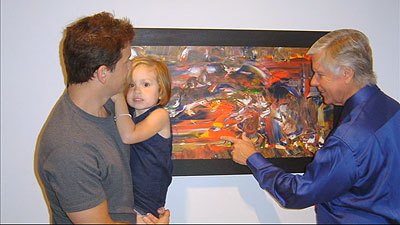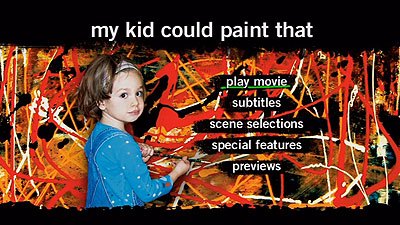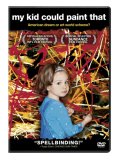| Reviews & Columns |
|
Reviews DVD TV on DVD Blu-ray 4K UHD International DVDs In Theaters Reviews by Studio Video Games Features Collector Series DVDs Easter Egg Database Interviews DVD Talk Radio Feature Articles Columns Anime Talk DVD Savant Horror DVDs The M.O.D. Squad Art House HD Talk Silent DVD
|
DVD Talk Forum |
|
|
| Resources |
|
DVD Price Search Customer Service #'s RCE Info Links |
|
Columns
|
|
|
My Kid Could Paint That
A girl, her paintings and a whole lot of controversy

Loves: Good documentaries
Likes: Art
Dislikes: Art collectors
Hates: Not being able to afford the art I enjoy
The Movie
I have a little girl, and I have no doubt she's a smart kid. It's not that she's composing symphonies or solving complex equations, but she shows that she "gets it" when she works out how to turn the TV on with the remote. no matter how fast she develops mentally from here though, I will not push her to become a prodigy. If she shows some talent, great, but I'm not shoving a tennis racquet in her hand when she's two.
If I manage to let her live a normal childhood, I probably won't be able to make hundreds of thousands of dollars off of her, nor will anyone make a documentary about her. In that way, she'll be nothing like Marla Olmstead, the star of My Kid Could Paint That. A precocious 4-year-old with a mop of blond hair and a kewpie-doll face, she doesn't look like the type of artist that could command five-figure price tags for her paintings, but her meteoric rise as a star in the world of modern art makes her a big-money talent overnight.

With that success though, comes a great deal of attention from the media, and eventually criticism and questions about the nature of modern art. After all, if an untrained preschooler can create such paintings, what does that say about the rest of the genre? Like modern art, Marla also finds herself being questioned, as some, including CBS' "60 Minutes," wonder how she could paint these works, positing that her father Mark, an amateur painter, may have helped her along the way. Thus begins a negative crash from the dizzying heights of art superstardom.
Director Amir Bar-Lev mixed the story of Marla and her parents with a larger argument about the nature of art, but found himself intricately involved in the tale, thanks to the time he spent with the little girl's family. It's the rare movie that lets an interview subject, like local journalist Elizabeth Cohen, ask questions of the filmmaker, which results in a pulling back of the curtain on the documentary process. Thus, when the media begin to attack them, the parents look to this filmmaker they trusted enough to allow into their home, for defense, but he finds it hard to deny theplausibility of the idea that Mark at least doctored the paintings (one passage visually comparing her publicly created work with her early paintings is particularly damning, if you think she may have had help.)
Bar-Lev's balance is impressive in capturing the ups and downs of the story in the peaks and valleys of the film, but it's the way the documentary becomes part of the documentary in a very meta way that makes it so interesting. Remove Bar-Lev from the story and it suddenly becomes a very standard film. And while Marla's tale is worth watching, it's not quite involved enough for a whole feature. That makes the decision to explore what art is and what goes on in the commercial side of art, with the help of New York Times art critic Michael Kimmelman, so smart. After all, the film needed a villain, and there are few more worthy of contempt than art collectors willing to spend what amounts to a year's salary for many people on a canvas with some splashes of paint. Marla's dad could be the mastermind behind a huge hoax, but there's nothing concrete, while Anthony Brunelli, the art gallery owner who brokers Marla's deal, doesn't seem like a bad guy, but the two-faced way he embraces her art, then dismisses his involvement as some sort of prank on the art world and welcomes her back again, makes him a bit unlikable. In a bit of delicious irony, though, he may be the best artist involved in the film, and doesn't get anywhere near the attention he deserves (for his art.)

The DVD
A standard keepcase holds a single-disc release, which features a static anamorphic widescreen main menu, with options to watch the film, adjust subtitles, select scenes and check out the bonus material. There are no audio options, while subtitles are available in English, French, Spanish, Chinese and Thai, along with closed captioning.
The Quality
The anamorphic widescreen transfer is a bit of a mixed bag, as much of the on-the-scene footage and source materials are a bit dull and rather soft, but the interviews and footage of photos and press clippings is bright and crisp. I've seen much better looking documentaries, and the age of this film should mean a better visual quality. On the plus side, aside from damage in the older source footage, the film is free of any defects or digital artifacts.
The Dolby Digital 5.0 soundtrack might be a bit more than the film really needed, but it does the job, delivering the dialogue cleanly, while presenting the film's sparse, jazzy score well, using the surrounds to give it a bit of heft. Everything sounds as it should, putting the emphasis where it is supposed to be, though some subtitles step in when the audio isn't captured perfectly.
The Extras
Up first is a feature-length audio commentary, which unfortunately doesn't include Bar-Lev. Instead, film editor John Walter is joined by Brunelli, creating a documentarian/subject dynamic. Brunelli, naturally, defends himself and the family, while Walter throws in notes about the construction of the film, but without Bar-Lev, there's an important point of view and source of information missing. Brunelli's too close to the story to be at all objective, and Walter, though he does a decent job as a moderator, didn't have enough involvement in the movie to provide the best commentary.
"Back to Binghamton" is a 35-minute compilation of little bits and pieces related to the film, including the film's premiere at Sundance, a Q&A session with Bar-Lev and some of the subjects, and various outtakes and clips. I wish it had been more of a follow-up (which should, by law, be included with all documentaries, in my opinion.) The most interesting of these are a couple of criticisms of Marla's paintings, including the thoughts of the curator of a local "Rude and Bold Women" art exhibition, who received an application from "Marla," including an artist's statement that's obviously not from her. It puts another questionable light onto her paintings. There's also a good deal of material with Bar-Lev, shot as he was driving, which, in some ways, fills in for some of what a commentary might have accomplished.
The 12-minute "Michael Kimmelman on Art" is a perfect supplement to the film's exploration of the meaning of art, as the art critic simply talks about the themes covered in the film, giving an expert's opinion. While he provides plenty of insight in the film, here, on his own, in a very organized way, he is able to provide something of a lecture on the nature of art and modern art, which is invaluable to the uninitiated.
The disc wraps with 15 trailers, many of which are for documentaries, though none for this film.

The Bottom Line
A quick, breezy documentary, My Kid Could Paint That is a fascinating human interest story blended with a rather intellectual exploration of the nature of modern art, resulting in a thorough look at a subculture most people have no in-depth knowledge of. That it's easy to step into the world of modern art via Marla's story is one of Bar-Lev's biggest successes in this film, but his post-modern involvement in the story makes it stand out from the usual, ethically-correct documentaries that keep a camera's-distance from the subject. The DVD looks OK and sounds solid, while the extras are just what you'd hope for from a documentary, though more involvement from the director or the family would have been appreciated. Even if you don't usually enjoy documentaries, this is one to check out, simply because of the unique story and the way it unfolds, which is loaded with the drama of a feature film, while ultimately leaving the conclusion up to the viewer.
Francis Rizzo III is a native Long Islander, where he works in academia. In his spare time, he enjoys watching hockey, writing and spending time with his wife, daughter and puppy.Follow him on Twitter
*The Reviewer's Bias section is an attempt to help readers use the review to its best effect. By knowing where the reviewer's biases lie on the film's subject matter, one can read the review with the right mindset.
|
| Popular Reviews |
| Sponsored Links |
|
|
| Sponsored Links |
|
|
| Release List | Reviews | Shop | Newsletter | Forum | DVD Giveaways | Blu-Ray | Advertise |
|
Copyright 2024 DVDTalk.com All Rights Reserved. Legal Info, Privacy Policy, Terms of Use,
Manage Preferences,
Your Privacy Choices | |||||||














